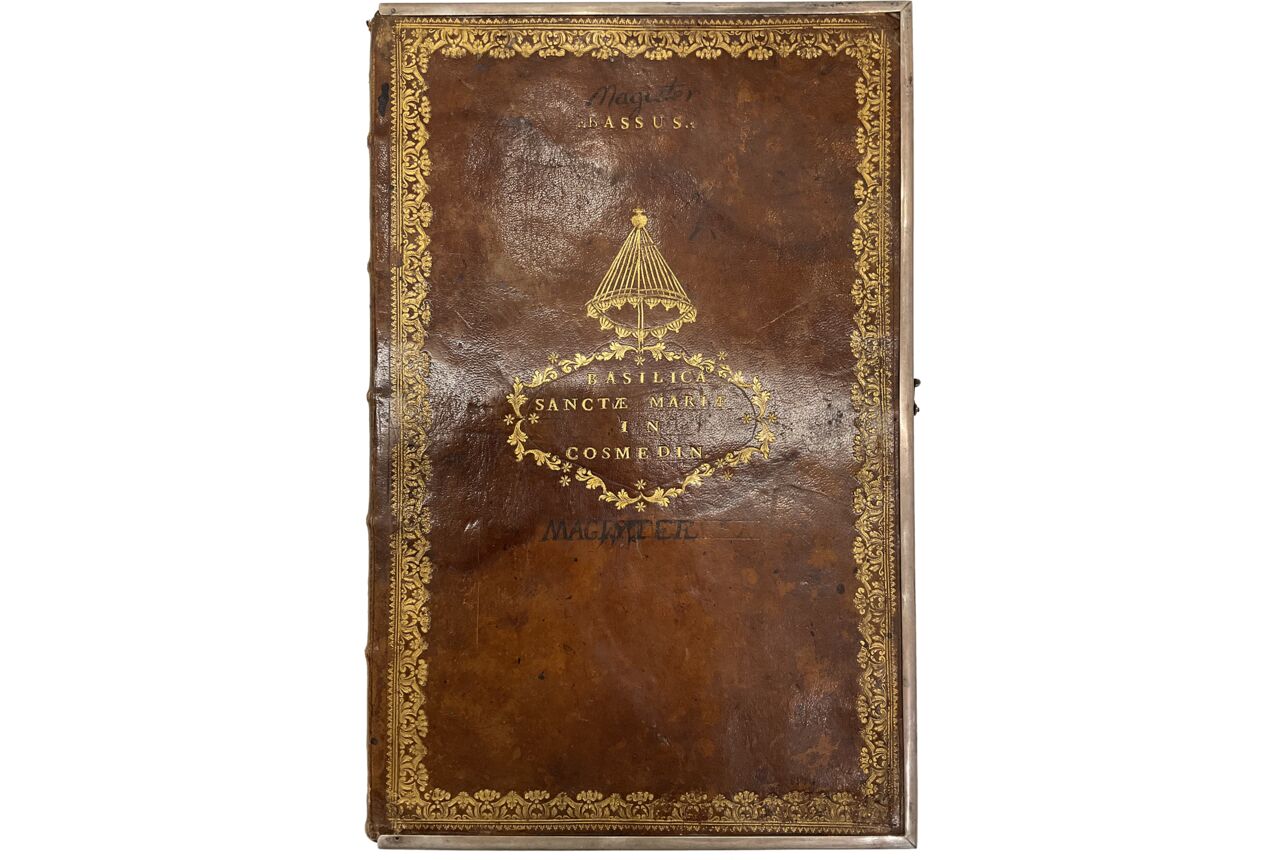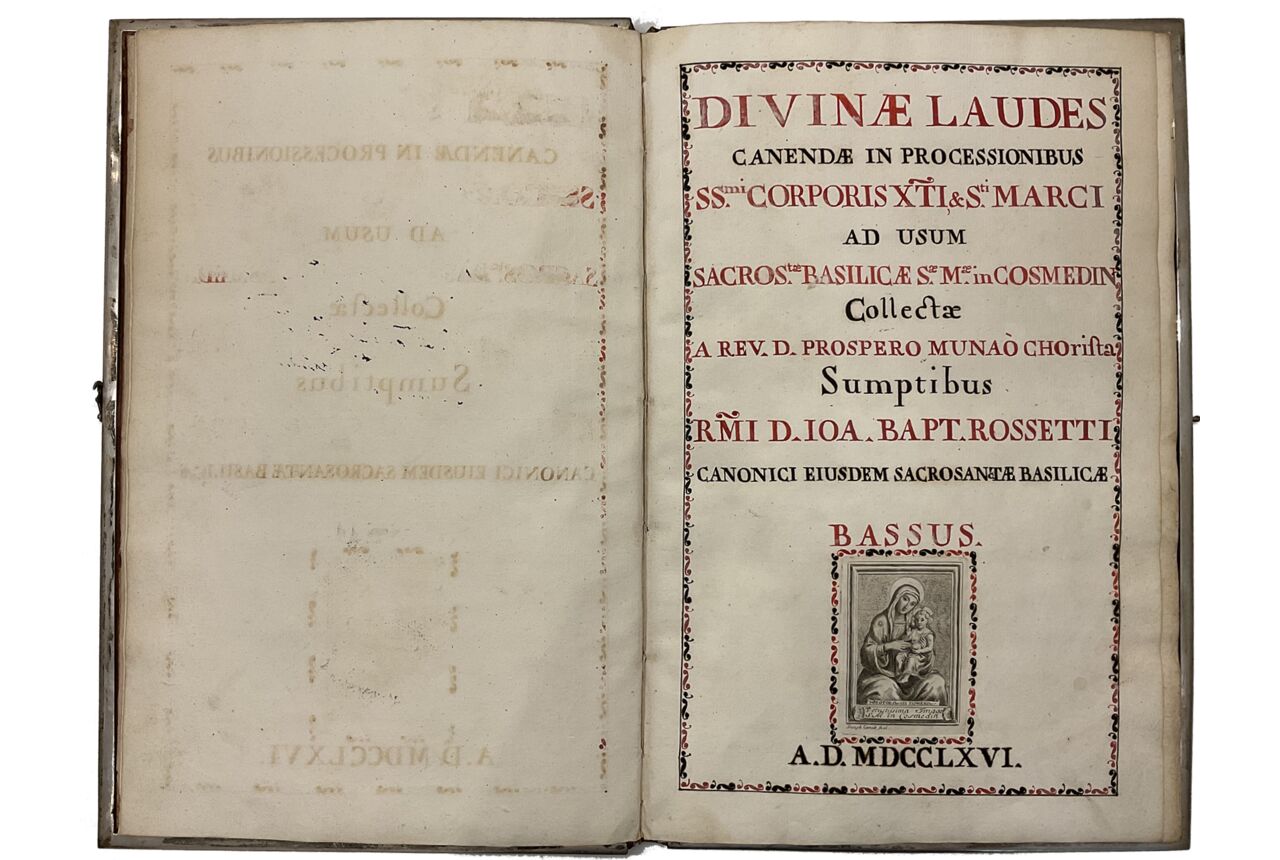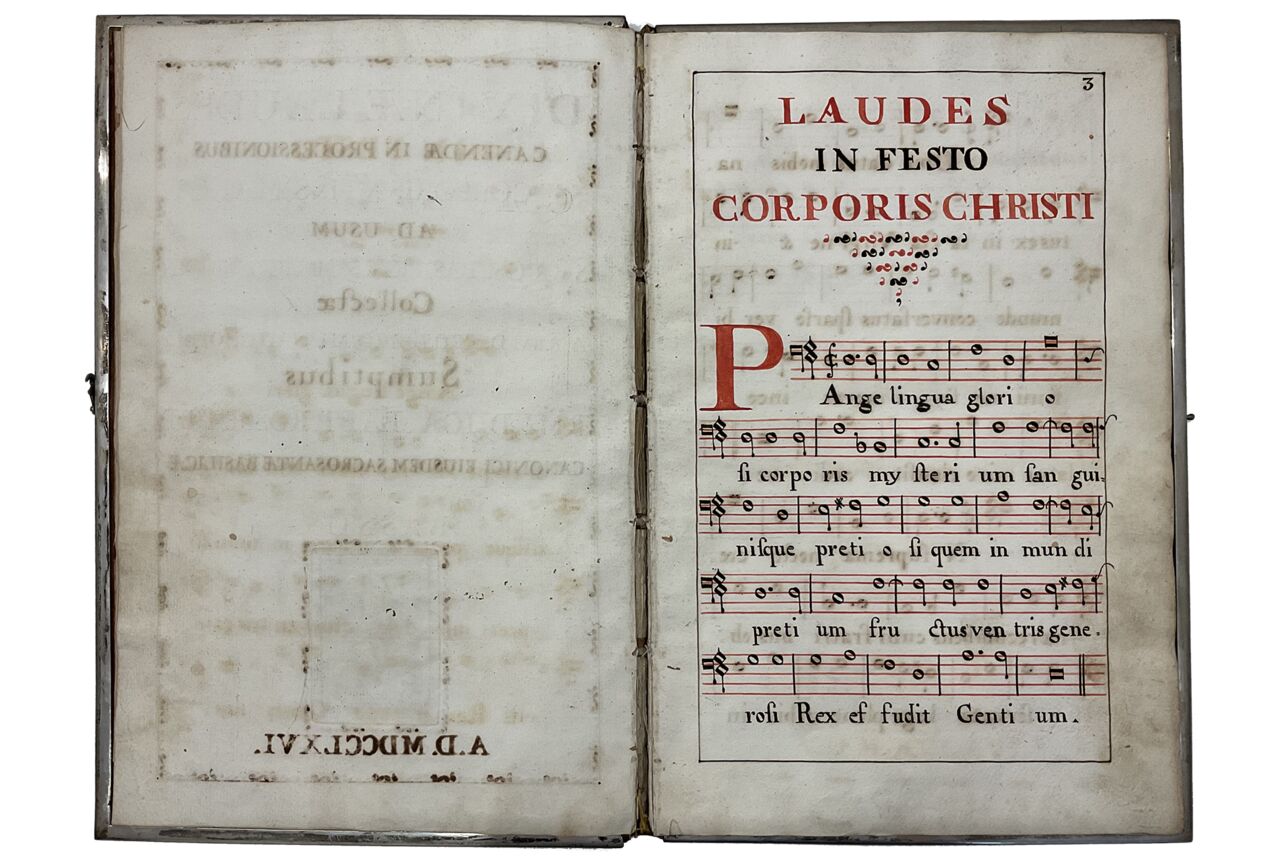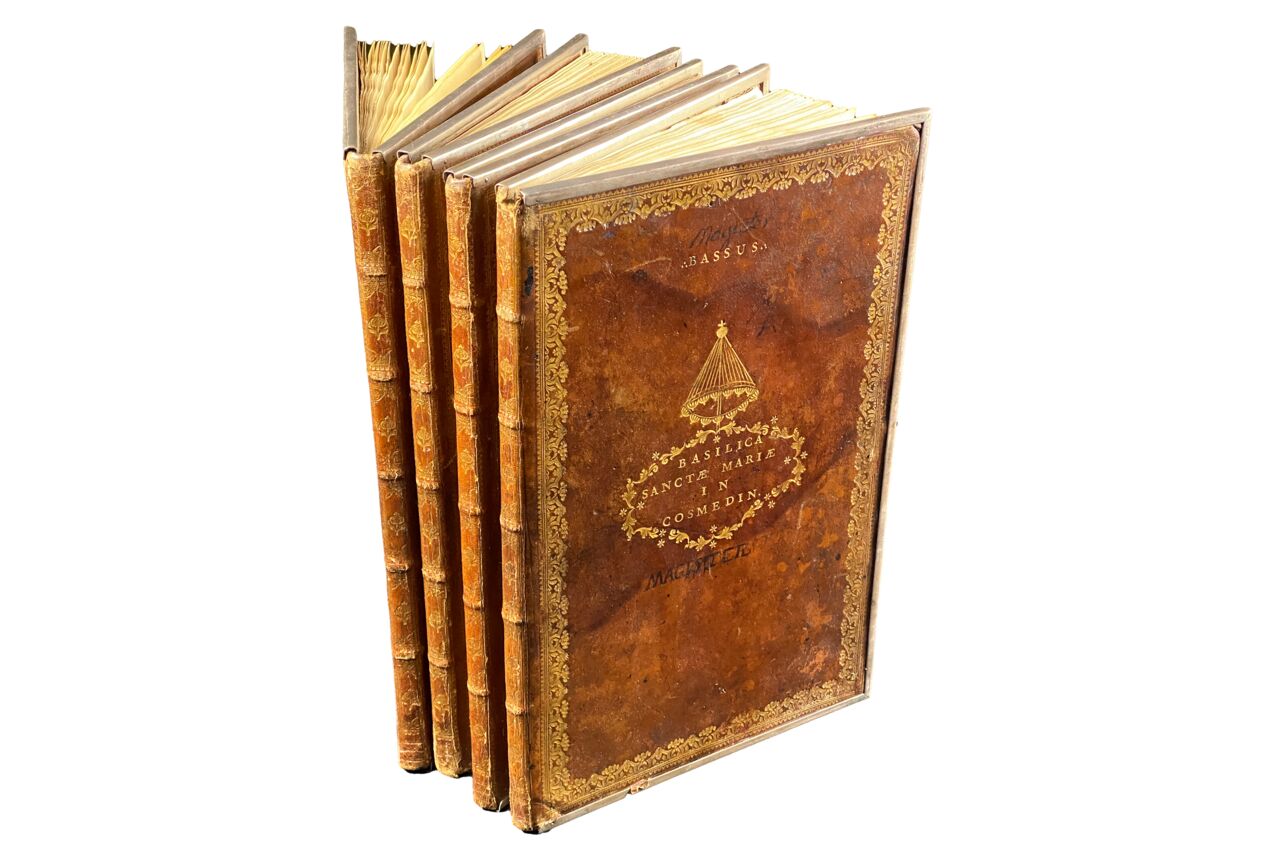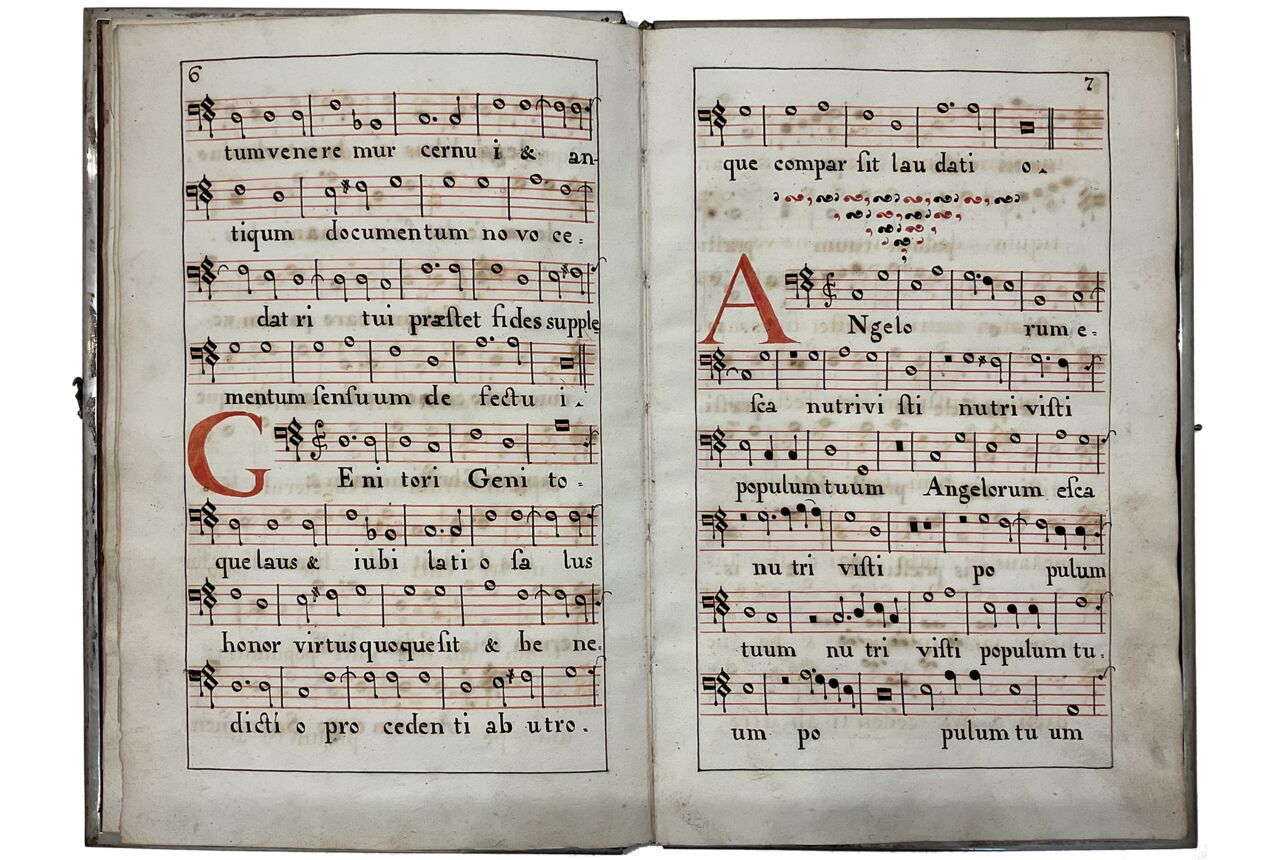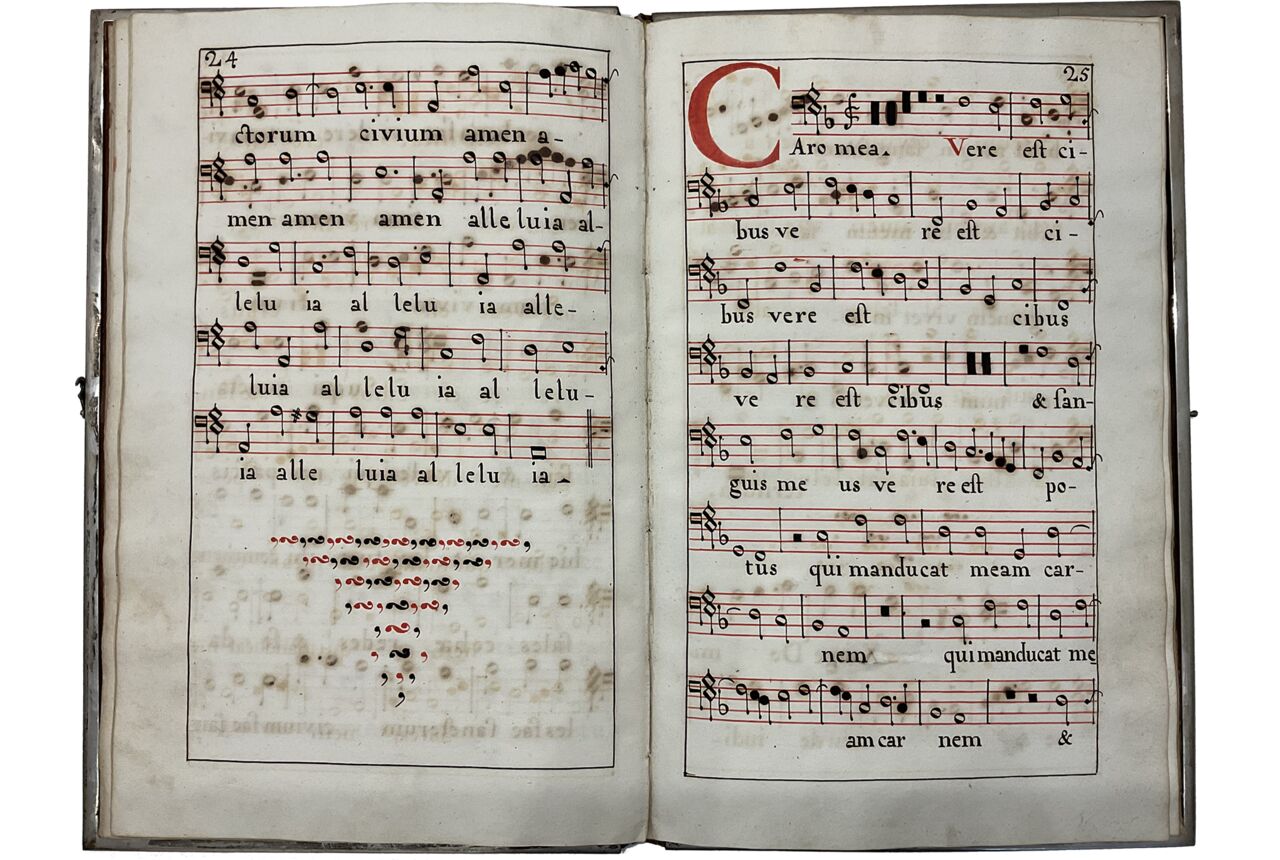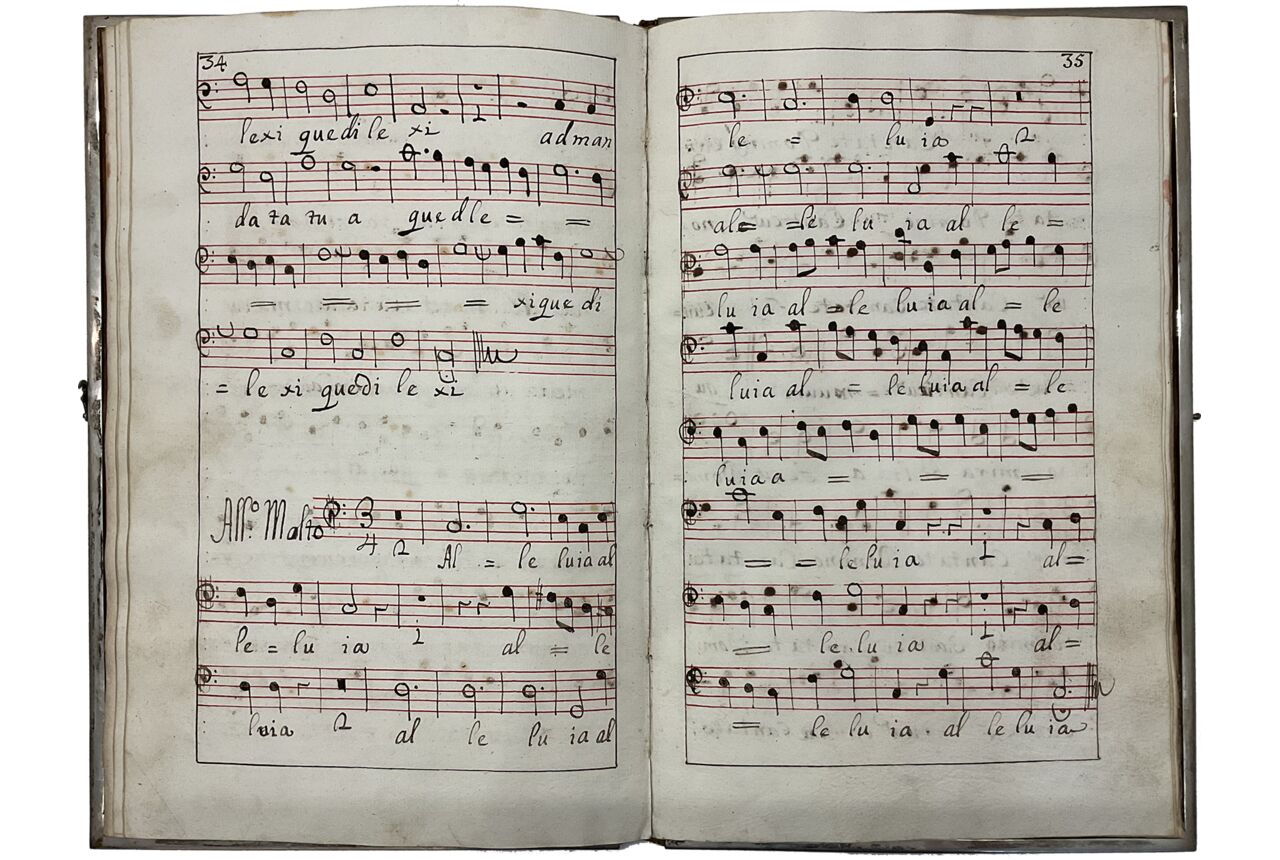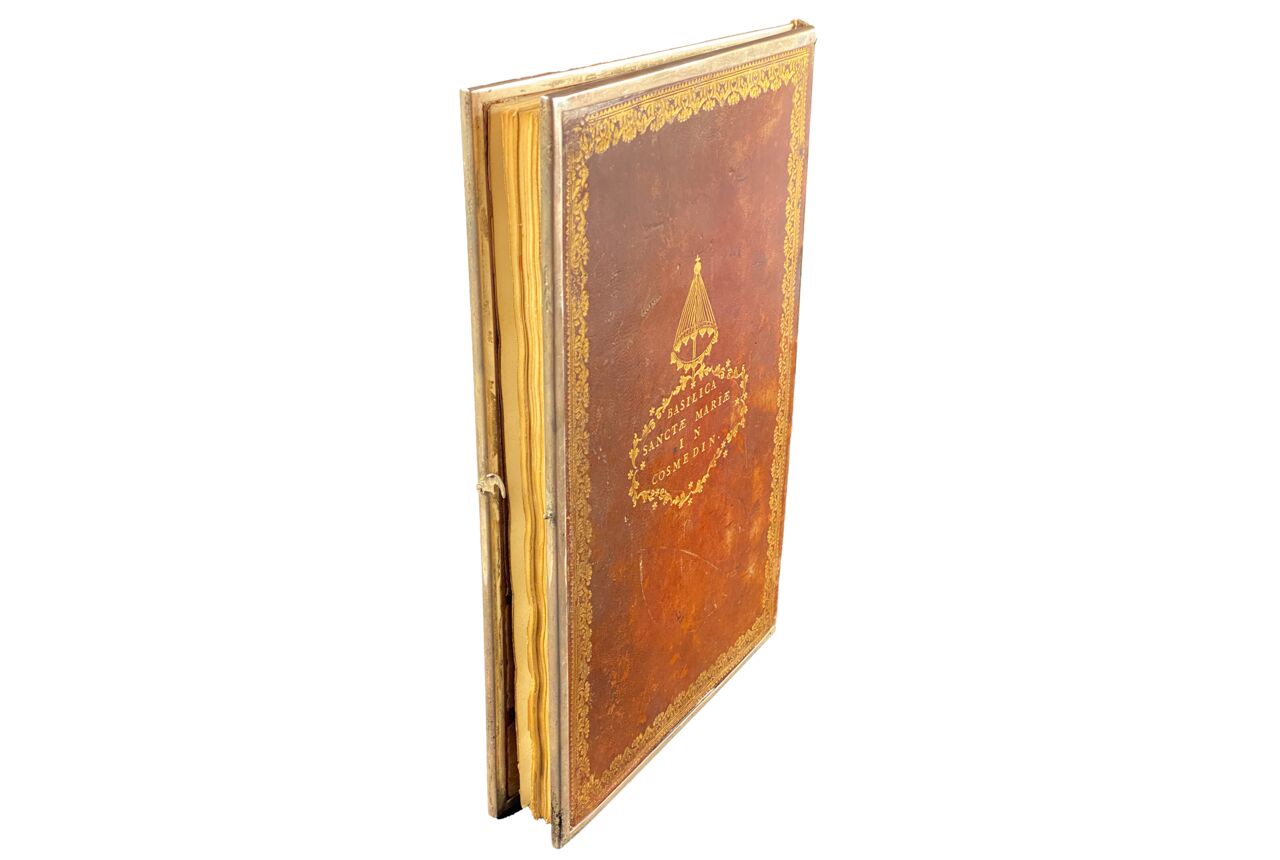4 vols, each iii + 25 + ii folios on paper (except cantus volume iii + 24 + ii, last blank leaf removed), watermark unidentified fleur-de-lis within a circle(?), original pagination in black ink, 3-35 (titlepage unnumbered), modern pagination in pencil, 36-50, complete (collation i2 [last front flyleaf + f. 1] ii-v6 (except last leaf removed in the cantus volume, no loss of text]), no catchwords or signatures, frame ruled in black ink (justification 320 x 187 mm.), all four volumes written by the same scribe in black ink in an eighteenth-century presentation script similar to humanistic script with eight staves and eight lines of text on each page, rastrum 20 mm., music written on five-line staves in red ink with oval hollow and oval solid note-heads, note-stems, dotted notes, and clef, later additions at the end of each volume in cursive hands, rubrics in red, initials in red, titles on titlepage and p. 3 alternating in lines of red and black capitals, on the titlepage of each volume is printed a signed copper engraving by the Roman engraver Giuseppe Canale (1725-1802) reproducing the Madonna di Cosmedin, very few minor stains and signs of use, all four volumes in overall excellent condition. In matching ORIGINAL SIGNED BINDINGS of brown morocco over pasteboards gold-tooled with a frame of delicate foliage lace and in the center of all front and back covers entitled in gilt “BASILICA SANCTAE MARIAE IN COSMEDIN” within a fine frame of small flowers and curving leaves, surmounted by a baldaquin crowned with a globe and cross, and at the top entitled in gilt “CANTUS,” “ALTUS” (on two volumes) and “BASSUS” (“Magister” inscribed twice in black ink on the cover of this volume), spine with five raised bands, gold-tooled with delicate pomegranates and small curving leaves, silver hooks and clasps and three-sided silver edges on the covers, signature “A.FRANCHI 925” engraved on the fore-edge of the silver on each volume, red marbled pastedowns and endpapers, minor stains and wear to leather, in overall excellent condition. Dimensions 370 x 240 mm.
Attesting to the continuation of the manuscript craft long after the invention of printing, this polyphonic Choir Book survives in four volumes, with separate volumes for the voices of Cantus, Altus (two volumes) and Bassus. The four manuscripts are well-preserved in their handsome original bindings with gold-tooled decoration and silver clasps and edges; the decorated titles pages include an engraved miniature by Giuseppe Canale representing the altarpiece known as Madonna di Cosmedin. This is a rare opportunity to acquire a fine music manuscript made for a prestigious church, the center for the Greek community in Rome, apparently unpublished.
Provenance
1.The four volumes were made for use during the processions on the feasts of Corpus Christi and St. Mark at the Basilica of Saint Mary in Cosmedin in Rome, with the chants collected in these volumes by Prospero Munaò, chorister of the Basilica, and Johannes Baptista Rossetti, canon, in 1766, as noted on the titlepage. (The texts for the Office of St. Mark were planned but never included in the volumes; see Text, below).
The Basilica Santa Maria in Cosmedin was the center of the Greek community resident in Rome.
2.The volumes continued to be used until the nineteenth century, as indicated by the additions made to the Magister Bassus volume for processions in 1860 and 1862.
Text
[unnumbered leaf, titlepage], “Divinae Laudes Canendae in Processionibus Sanctissimi Corporis Christi et Sancti Marci ad Usum Sacrosanctae Basilicae Sancte Marie in Cosmedin Collectae a Rev. D. Prospero Munaò Chorista Sumptibus Rmi D. Ioa. Bapt. Rossetti canonici eiusdem sacrosanctae basilicae. Cantus [or Altus or Bassus; (engraved miniature) A.D. MDCCLXVI. [1766]”;
pp. 3-32, [Chants for the office of Corpus Christi;, title], Laudes in festo Corporis Christi; beginning with the hymn Pange lingua attributed to St. Thomas Aquinas, pp. 3-7, incipit, “Pange lingua gloriosi corporis mysterium ... Compar sit laudatio”; pp. 7-8, the antiphon Angelorum esca, …; p. 30, ending with the antiphon, incipit, “Adoramus te Christe et benedicimus tibi quia per crucem tuam redemisti mundum,” and the chant Cantate Domino (Ps. 149:1-2); [pp. 31-32, last initial “C” left unpainted in all volumes except Bassus];
pp. 33-44/45, [Chants added later in cursive script, possibly near contemporary to the preceding pages, beginning with the Offertory for Lent], pp. 33-34, Meditabor in mandatis tuis; pp. 35-38, followed by alleluia verses and Cantate Domino in all volumes; pp. 39-45 (pp. 39-44 in Bassus), hymn Ave Maris Stella in all but the second Altus volume (where the following pages are ruled for staves, otherwise blank); [the rest of the pages are ruled for staves but otherwise blank in Cantus and the first Altus volume];
pp. 44-50, [in Bassus volume only], New versions of the hymn Ave Maris Stella added in a smaller cursive script in the nineteenth century, first for a procession of the image of the Virgin transported from the Basilica Santa Maria Maggiore (Liberian Basilica) to the Church of Jesus on 8 July 1860, and second, for a procession celebrating the canonization of the twenty-six martyrs of Japan on 8 June 1862, “Magister. Ave maris stella. Inno cantato per la solenne processione dell’Immagine di Maria Sanctissima che dalla Basilica Patriarcale Liberiana venne trasportata alla Chiesa del Gesu, Dominica 8 Luglio 1860. Originale di Giuseppe Clementi M° dis. Maria in Cosmedin ... Il presente Inno venne replicato per la Processione della Canonissasione dei Ventisette (sic) Martiri del Giappone il giorno di Pentecoste 8 Giugno 1862.”
There are no chants for the feast of St. Mark, which are indicated on the titlepage and were presumably planned initially.
Illustration
Printed on the titlepages of each volume is a signed copper engraving by the Roman engraver Giuseppe Canale (1725-1802) reproducing the Theotokos (Mother of God) altarpiece of the basilica, also known as the Madonna di Cosmedin. This fourteenth-century work by a Roman artist was canonically crowned by Pope Clement X in 1672. It is now kept in the chapel of the winter choir, built in 1686 (the part of the church where the Office was chanted during the winter, when the main church would get too cold). On the engraving the altarpiece is entitled “Theotokos aei parthenos” (mother of God, always a virgin) and “Vetustissima Imago S. M. in Cosmedin.”
The Basilica di Santa Maria in Cosmedin was built in the sixth century in an area of Rome populated by Greek immigrants, and the church was originally known as Santa Maria Schola Graeca. In the eighth century the Byzantine monks escaping the iconoclastic persecutions in Greece arrived here and brought with them artistic skills, building the current church and adorning it with splendid decorations in Greek style. The basilica then earned the name Cosmedin, which derives from the Greek word κοσμίδιον (kosmidion), a thing of beauty. The church was restored in the twelfth, eighteenth, and nineteenth centuries. In the portico of the church can be found the famous Bocca della Verità (Mouth of Truth), an ancient Roman marble disc sculpted in the shape of a mask. An enduring medieval legend states that if a person places his hand inside the mouth and utters a lie, the mouth will bite off his hand. In the Middle Ages this belief was taken so seriously that the Bocca della Verità was used as a “lie detector” in trials, especially against adulteresses.
These manuscripts were made for a very specific use in processions that can be localized and dated, offering an especially valuable source for research. Their fine silver-edged bindings reflect the prestigious provenance, Santa Maria in Cosmedin, one of the most important Roman basilicas and a symbol of the city itself. Interestingly, the Basilica di Santa Maria in Cosmedin preserves its thirteenth-century “schola cantorum,” two pulpits and related canopies in the center of the nave for singing the liturgy.
This manuscript to the best of our knowledge represents a new source for the study of liturgical music in late eighteenth-century Rome, an under-studied but promising area of musical history (for example, see Peter Leech’s 2017 blog; Online Resources).
LIterature
Crescimbeni, G. M. Stato della basilica diaconale, collegiate, e parrocchiale di S. Maria in Cosmedin di Roma, Rome, 1719.
Fusciello, G. Santa Maria in Cosmedin a Roma, Rome, 2011.
Harper, J. The Forms and Orders of Western Liturgy from the Tenth to the Eighteenth Century: A Historical Introduction and Guide for Students and Musicians, Oxford, 1991.
Huglo, M. Les livres de chant liturgique, Turnhout, 1988.
Online Resources
Peter Leech, “Unlocking the Secrets of Sacred Music in late-eighteenth-century Rome: Detective Work in Dusty Libaries,” 9 January 2017
Unlocking the Secrets of Sacred Music in Late-Eighteenth-Century Rome: Detective Work among Dusty Manuscripts (toccataclassics.com)
Santa Maria in Cosmedin (Wikipedia)
https://en.wikipedia.org/wiki/Santa_Maria_in_Cosmedin
Cantus Planus
https://www.uni-regensburg.de/Fakultaeten/phil_Fak_I/Musikwissenschaft/cantus/
Latin chants of the Mass and Divine Office from the Gregorian repertory
https://gregorien.info/en
TM 1147


